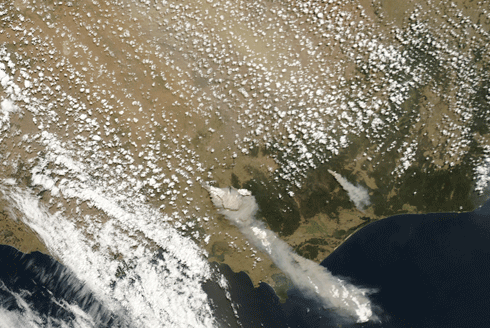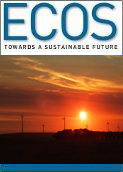
|
Published: 13 August 2012
Black Saturday’s deadly weather secrets revealed
An in-depth analysis of weather conditions during Australia’s worst bushfires could help to improve public warning systems and fire management strategies.

|
|
Satellite image taken at 3:50pm on 7 February 2009 showing smoke plumes and clouds arranged into 'streets' by horizontal convective rolls. Credit: NASA/GSFC - Rapid Response
|
More than three years after the Black Saturday bushfires in Victoria, researchers still seek answers to what caused them and how such devastation – of families, communities and natural resources – might be avoided in future.
In groundbreaking work published in the Quarterly Journal of the Royal Meteorological Society, researchers have produced detailed, high-resolution simulations of weather patterns on 7 February 2009 that provide insights for future fire management and warning systems.
The team – led by Dr Todd Lane and Ms Chermelle Engel from The University of Melbourne with Prof Michael Reeder from Monash University and Dr Michael Rezny from the ARC Centre of Excellence for Climate System Science – examined meteorological conditions across Victoria on Black Saturday.
The analysis used a high-resolution weather forecasting model that represented the airflow over the entire state on 400 metre grids: about ten times smaller than the grids used in operational weather forecasting. The model was validated using weather conditions observed on the day.
‘Fire fighters reported extraordinary behaviour from the Black Saturday bushfires. We wanted to understand what weather characteristics produce these extreme conditions to aid future fire control efforts,’ said Dr Lane.
‘We found that weather events at a horizontal scale of about 10 kilometres introduced variability in the wind, temperature and humidity conditions. These smaller events combined to produce significant variability in fire danger across much of Victoria.’
The study also identified other factors that may have contributed to the severity of the 2009 bushfires. ‘Similar wind patterns have been observed previously on hot days, but the convective rolls [of air] on Black Saturday were unusual as the high temperatures meant they were stronger and spaced wider apart,’ added Dr Lane.
‘The rolls create bands of fast and slow wind around 5-10 kilometres apart, causing variations in fire danger. Fire spread is related to wind speed and the rolls might have caused fires to behave differently over a relatively small distance.’
On the day, a strong late-afternoon cool change and a second weaker late-evening cool change altered conditions dramatically as fire-fronts moved across the state.
One of the most astonishing results from the study, according to Professor Reeder, was that after sunset, the cold front generated a distinct wave in the atmosphere.
‘This wave propagated ahead of the front and appeared to have reinvigorated the fire around Beechworth. Although we believe that this kind of behaviour is common, this is the first time it has been documented.’
Ms Engel says the research could benefit communities at risk of bushfires: ‘With improved computing power in the future, this kind of analysis should be useful for operational forecasting on days of fire danger, providing a better guide for public warning systems and fire fighting resources.’
Source: University of Melbourne



